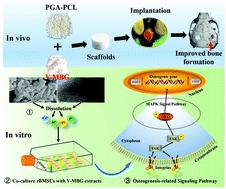当前位置:
X-MOL 学术
›
J. Mater. Chem. B
›
论文详情
Our official English website, www.x-mol.net, welcomes your
feedback! (Note: you will need to create a separate account there.)
Ion release behavior of vanadium-doped mesoporous bioactive glass particles and the effect of the released ions on osteogenic differentiation of BMSCs via the FAK/MAPK signaling pathway
Journal of Materials Chemistry B ( IF 6.1 ) Pub Date : 2021-08-11 , DOI: 10.1039/d1tb01479j Jiangfeng Li 1 , Junying Li 1 , Yuhao Wei 2 , Na Xu 1 , Jingtao Li 2 , Ximing Pu 1 , Juan Wang 1 , Zhongbing Huang 1 , Xiaoming Liao 1 , Guangfu Yin 1
Journal of Materials Chemistry B ( IF 6.1 ) Pub Date : 2021-08-11 , DOI: 10.1039/d1tb01479j Jiangfeng Li 1 , Junying Li 1 , Yuhao Wei 2 , Na Xu 1 , Jingtao Li 2 , Ximing Pu 1 , Juan Wang 1 , Zhongbing Huang 1 , Xiaoming Liao 1 , Guangfu Yin 1
Affiliation

|
Vanadium is an important trace element in bone and is involved in bone metabolism, bone formation, and bone growth, but the roles of various vanadium ions, especially of pentavalent vanadium, in bone tissue regenerative repair have been underestimated and even misinterpreted for a long time. The main purposes of this study are to investigate the release profile of Si, Ca, P, and V ions from vanadium doped mesoporous bioactive glass (V-MBG) particles and to explore the effect of pentavalent vanadium ions on proliferation and osteogenic differentiation of BMSCs as well as the corresponding osteogenic signaling pathway. On the basis of preparations of V-MBG particles with different pentavalent vanadium contents, the ion release behavior from V-MBG in distilled water and simulated body fluid was systemically investigated. Furthermore, the cytocompatibility and osteogenic effect of V-MBG extracts were studied in rBMSCs, and the related molecular mechanisms were preliminarily discussed. The results of dissolution experiments showed that the V ionic concentration exhibited a burst increase and then a sustained slow increase in the two media. The resultant V ions from 1.0V-MBG, 4.0V-MBG and 10.0V-MBG at 21 days were about 1.1, 5.8, and 12.5 mg L−1 in water, respectively, and 1.6, 4.8 and 12.8 mg L−1 in SBF, respectively. The release behaviors of Si, Ca, P, and V ions were evidently affected by high contents of incorporated vanadium. The cellular results indicated that compared to the control and MBG groups, the V(V) ions in V-MBG extracts at about 19.4 μM markedly promoted the proliferation, the gene and protein expression of BMP-2 and COL-I, and the ALP activity of rBMSCs in non-osteoinductive media, but insignificantly stimulated the OCN protein synthesis. More deeply, V(V) ions at about 19.4 μM significantly upregulated the gene and protein expressions of Itga 2b, FAK, and pERK1/2, demonstrating that V(V) ions could regulate osteogenic differentiation of rBMSCs through the activation of the Itga 2b–FAK–MAPK (pERK1/2) signaling pathway. The in vivo results further confirmed that V-MBG induced and promoted new bone formation in the defect area compared to the PGC and PGC/V-M0 groups. These results would contribute to modify the perception about the biocompatibility and osteogenic promotion of pentavalent vanadium at an appropriate concentration.
中文翻译:

掺钒介孔生物活性玻璃颗粒的离子释放行为及释放的离子通过FAK/MAPK信号通路对骨髓间充质干细胞成骨分化的影响
钒是骨中重要的微量元素,参与骨代谢、骨形成和骨生长,但长期以来各种钒离子,尤其是五价钒在骨组织再生修复中的作用一直被低估甚至曲解。 . 本研究的主要目的是研究钒掺杂介孔生物活性玻璃(V-MBG)颗粒中Si、Ca、P和V离子的释放曲线,并探讨五价钒离子对骨髓间充质干细胞增殖和成骨分化的影响。以及相应的成骨信号通路。在制备不同五价钒含量的V-MBG颗粒的基础上,系统研究了V-MBG在蒸馏水和模拟体液中的离子释放行为。此外,研究了V-MBG提取物在rBMSCs中的细胞相容性和成骨作用,并初步探讨了相关分子机制。溶出实验结果表明,V离子浓度在两种介质中呈现爆发式增加,然后持续缓慢增加。1.0V-MBG、4.0V-MBG 和 10.0V-MBG 在第 21 天得到的 V 离子约为 1.1、5.8 和 12.5 mg·L在水中分别为-1,在 SBF 中分别为 1.6、4.8和 12.8 mg L -1 。Si、Ca、P和V离子的释放行为明显受到高掺钒量的影响。细胞结果表明,与对照组和 MBG 组相比,V-MBG 提取物中约 19.4 μM 的 V( V ) 离子显着促进 BMP-2 和 COL-I 的增殖、基因和蛋白表达,以及 ALP rBMSCs 在非骨诱导培养基中的活性,但对 OCN 蛋白合成的刺激作用不大。更深入地讲,约 19.4 μM 的 V( V ) 离子显着上调 Itga 2b、FAK 和 pERK1/2 的基因和蛋白表达,证明 V( V )) 离子可以通过激活 Itga 2b-FAK-MAPK (pERK1/2) 信号通路来调节 rBMSCs 的成骨分化。体内结果进一步证实,与 PGC 和 PGC/V-M0 组相比,V-MBG 在缺损区域诱导和促进新骨形成。这些结果将有助于改变对五价钒在适当浓度下的生物相容性和成骨促进作用的看法。
更新日期:2021-08-27
中文翻译:

掺钒介孔生物活性玻璃颗粒的离子释放行为及释放的离子通过FAK/MAPK信号通路对骨髓间充质干细胞成骨分化的影响
钒是骨中重要的微量元素,参与骨代谢、骨形成和骨生长,但长期以来各种钒离子,尤其是五价钒在骨组织再生修复中的作用一直被低估甚至曲解。 . 本研究的主要目的是研究钒掺杂介孔生物活性玻璃(V-MBG)颗粒中Si、Ca、P和V离子的释放曲线,并探讨五价钒离子对骨髓间充质干细胞增殖和成骨分化的影响。以及相应的成骨信号通路。在制备不同五价钒含量的V-MBG颗粒的基础上,系统研究了V-MBG在蒸馏水和模拟体液中的离子释放行为。此外,研究了V-MBG提取物在rBMSCs中的细胞相容性和成骨作用,并初步探讨了相关分子机制。溶出实验结果表明,V离子浓度在两种介质中呈现爆发式增加,然后持续缓慢增加。1.0V-MBG、4.0V-MBG 和 10.0V-MBG 在第 21 天得到的 V 离子约为 1.1、5.8 和 12.5 mg·L在水中分别为-1,在 SBF 中分别为 1.6、4.8和 12.8 mg L -1 。Si、Ca、P和V离子的释放行为明显受到高掺钒量的影响。细胞结果表明,与对照组和 MBG 组相比,V-MBG 提取物中约 19.4 μM 的 V( V ) 离子显着促进 BMP-2 和 COL-I 的增殖、基因和蛋白表达,以及 ALP rBMSCs 在非骨诱导培养基中的活性,但对 OCN 蛋白合成的刺激作用不大。更深入地讲,约 19.4 μM 的 V( V ) 离子显着上调 Itga 2b、FAK 和 pERK1/2 的基因和蛋白表达,证明 V( V )) 离子可以通过激活 Itga 2b-FAK-MAPK (pERK1/2) 信号通路来调节 rBMSCs 的成骨分化。体内结果进一步证实,与 PGC 和 PGC/V-M0 组相比,V-MBG 在缺损区域诱导和促进新骨形成。这些结果将有助于改变对五价钒在适当浓度下的生物相容性和成骨促进作用的看法。











































 京公网安备 11010802027423号
京公网安备 11010802027423号